January 1st, 2018 Carriers’ addresses were published by newspapers, usually on January 1, and distributed in the United States for more than two centuries. The custom originated in England and was introduced here during colonial times. The newsboys delivered these greetings in verse each New Year’s Day and the customers understood that a tip was expected. The poems, often anonymous, describe the events of the past year, locally, regionally, and nationally, and end with a request for a gratuity for the faithful carrier. Often the poem referred to the carrier’s diligence and hardships during winter weather. Illustrated with wood-engravings and decorative borders, carriers’ addresses are distinctive examples of popular publishing in nineteenth century America.
Brown University Library Center for Digital Scholarship
Spencer Research Library has several carriers’ addresses in its holdings, including one distributed in Lawrence on January 1, 1870, to readers of the Republican Daily Journal newspaper.

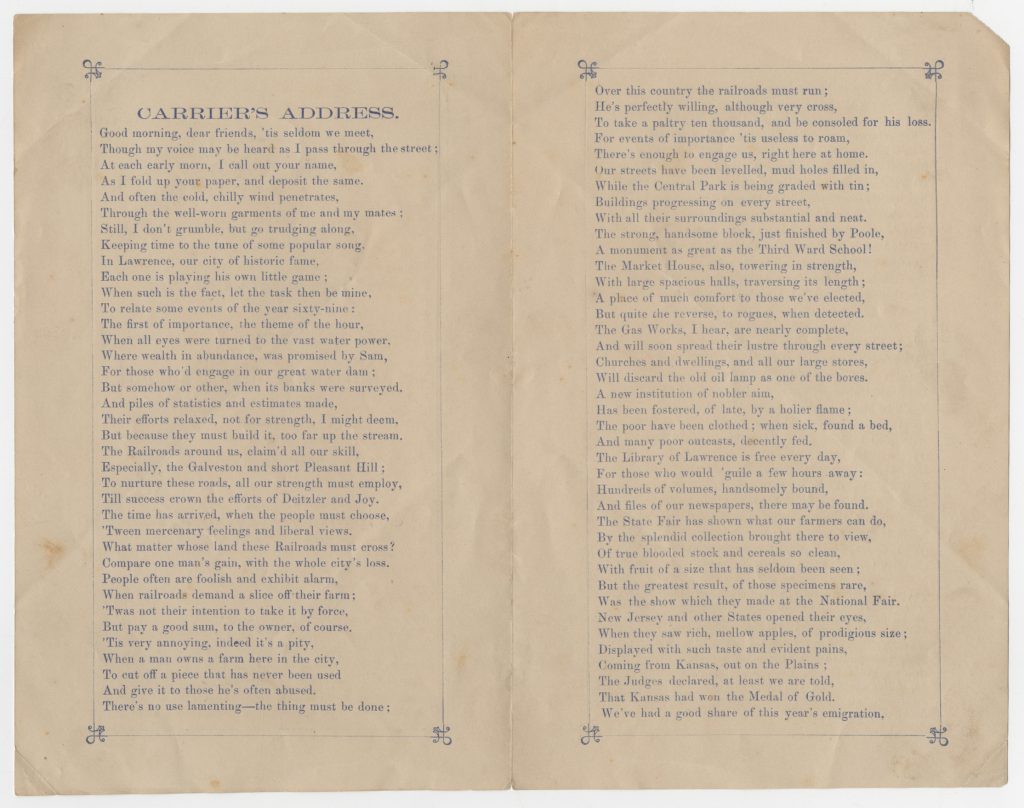
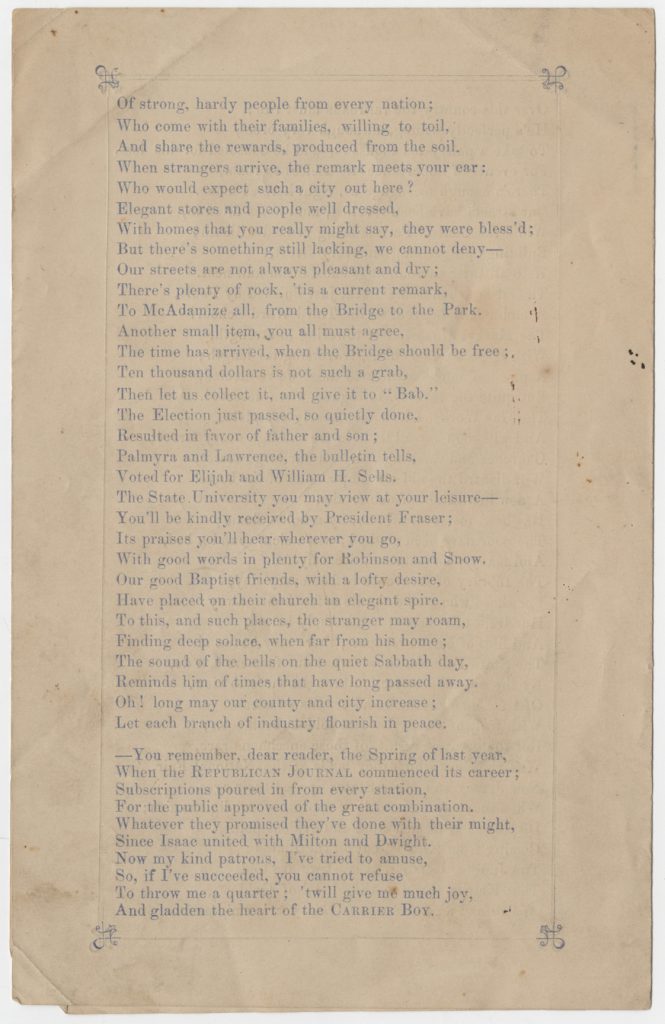
Carrier’s Address to the Patrons of the Republican Daily Journal,
Lawrence, Kansas, January 1st, 1870: Happy New Year.
Call Number: RH P629. Click images to enlarge.
The poem notes that “For events of importance ’tis useless to roam/There’s enough to engage us, right here at home.” Throughout 1869, Lawrence residents were focused on several local events and topics, including the following, mentioned in the text:
- A failed attempt to build a dam on the Kansas River.
- Controversies about the railroad (“what matter whose land these Railroads must cross?”) and the tolls charged to use the only bridge crossing the Kansas River at Lawrence (“the time has arrived, when the Bridge should be free”).
- Road improvements and remaining problems.
- New buildings, including the gas works (a plant for manufacturing gas and especially illuminating gas) and the First Baptist Church.
- Praise for the city Library and the University of Kansas.
- The success of the Kansas State Fair (held in Lawrence, September 7-10) and Kansas entries at the National Fair.
- Immigrants moving to Lawrence
- The election of Elijah Sells and his son William H. Sells to represent two of Douglas County’s six districts in the Kansas Legislature.
What did Lawrence look like in 1869? Check out a bird’s-eye view of the town from that year, digitized by the Library of Congress. Be sure to zoom in to see all of the details. (Spencer Research Library also has a copy of this map.)
Caitlin Donnelly
Head of Public Services
Tags: Caitlin Donnelly, Carriers' Addresses, Kansas Collection, Lawrence, Lawrence KS, New Year's Day
Posted in Kansas Collection |
No Comments Yet »
January 26th, 2017 Each week we’ll be posting a photograph from University Archives that shows a scene from KU’s past. We’ve also scanned more than 34,500 images from KU’s University Archives and made them available online; be sure to check them out!
Happy birthday, Kansas! Kansas Day is this Sunday, January 29th, and we’re celebrating with a fun photograph from the 1954 Kansas Relays Parade.
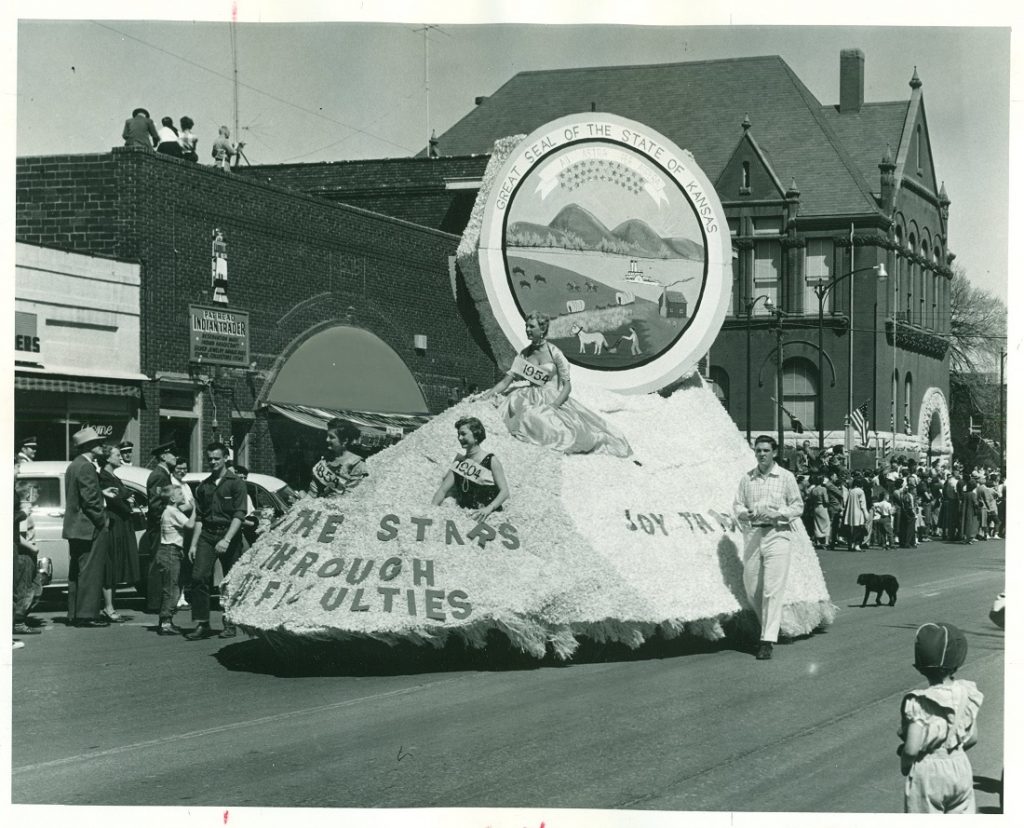
A Kansas-themed float in the Kansas Relays Parade, 1954. The year marked
the 100th anniversary of the Kansas-Nebraska Act, which established
Kansas Territory. University Archives Photos. Call Number: RG 71/2 1954 Prints:
Student Activities: Kansas Relays (Photos). Click image to enlarge.
The picture was taken on Massachusetts Street just south of Eleventh. The Watkins Museum of History is prominent in the background; the building originally housed the J. B. Watkins Land Mortgage Company and the Watkins National Bank, and it served as Lawrence’s City Hall from 1929 to 1970.
Be sure to also check out last year’s Kansas Day image: a photograph of girls in sunflower costumes in the 1949 Kansas Relays Parade.
Caitlin Donnelly
Head of Public Services
Melissa Kleinschmidt and Abbey Ulrich
Public Services Student Assistants
Tags: Abbey Ulrich, Caitlin Donnelly, Kansas Day, Kansas Relays, Kansas Relays Parade, KU History, Lawrence, Massachusetts Street, Melissa Kleinschmidt, photographs, Throwback Thursday, University Archives, University history, University of Kansas
Posted in Throwback Thursday |
No Comments Yet »
July 13th, 2015 One of my favorite group of objects that has come to Conservation Services for housing is the Zodiac Club peanut doll collection, housed in the Kansas Collection. As the name implies, it is a series of dolls made from shelled peanuts for heads, with wire bodies and intricate, period-appropriate dress.
The Zodiac Club was founded as women’s studying group, organized on February 5, 1878, by nine women from the Lawrence, KS area. Over the years the club met in members’ homes every Tuesday to read and discuss items relating to “cultural improvement.”
In 1943, when the Zodiac Club celebrated its 65th anniversary, twelve dolls were made to represent the original members of the Zodiac Club. The dolls are made of a frame of covered wire with peanuts for faces and dressed in costumes from the 1870s. Besides the dolls, the collection includes miniature period furniture, as well as leather-bound books, a tea service, spinning wheel, tintype photographs, needlepoint, and braid rug.
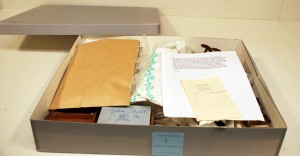
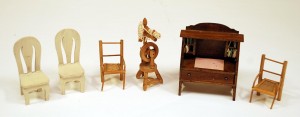
Left: Zodiac Club doll collection before housing. Right: Examples of the other items housed with the dolls.
Kansas Collection, call number RH MS Q61.
All the dolls, furniture, and other items were wrapped in paper towels and placed together in a box, making it difficult to tell what was in the box and to access particular items. A museum studies student intern was assigned to rehouse the collection into a more usable form.

Peanut-headed doll wrapped in paper towel. Note the fine detail in the costume.
Kansas Collection, call number RH MS Q61.
I asked her to create a housing that would keep the dolls and the other items in one box. She devised an ingenious two-tray system: the furniture and other items that are less frequently accessed are on the bottom layer, and the dolls are in a removable tray on top. Featured on the outside and inside of the box is a diagram that indicates how everything fits in the housing. Now the peanut ladies will be better protected and more easily displayed for many years to come.
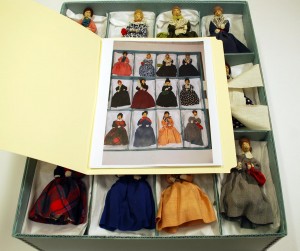
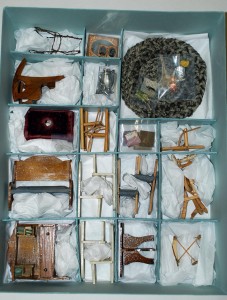
Left: Top tray with dolls and housing guide. Right: Bottom tray with furniture and other items.
Kansas Collection, call number RH MS Q61.
Whitney Baker
Head, Conservation Services
Tags: dollhouse furniture, KS, Lawrence, peanut doll, protective enclosures, Whitney Baker, women, Zodiac Club
Posted in Conservation, Kansas Collection |
No Comments Yet »
February 7th, 2014 It’s been an exciting week or two in Lawrence for scholars and fans of William S. Burroughs. Wednesday, February 5 was the centenary of the writer’s birth, and around town events and exhibitions have been exploring his writing, art, and deep ties to Lawrence. Burroughs made Lawrence his home during the last fifteen years of his life, and now, thanks to a gift from James Grauerholz, executor of the Burroughs estate and a KU alumnus, the influential author’s last journals will join the collections of KU Libraries.
Burroughs helped revolutionize the post-WWII literary landscape with novels like Naked Lunch and Nova Express, the latter a part of his cut-up trilogy. To celebrate the gift, five of the ten journals will be on display in the Kenneth Spencer Research Library’s lobby through February. These notebooks, which span from November 1996 to Burroughs’ death in August of 1997, were the basis for Last Words: The Final Journals of William S. Burroughs, a volume edited by Grauerholz and published in 2000. In their pages we see literature, politics, art, and philosophy collide with everyday life. A reference to speaking with an ailing friend, poet Allen Ginsberg (“His voice over the phone from Beth Israel Hospital in NYC sounded very weak”), appears alongside a reminder to buy disposable razors. The final entry (see below) offers a meditation on conflict and love. To the left Burroughs has written: “Love? What is it? / Most natural pain / killer what there is. / L O V E.”

William S. Burroughs’ final journal. Image courtesy of Chuck France / KU Office of Public Affairs. Click here for a larger version.
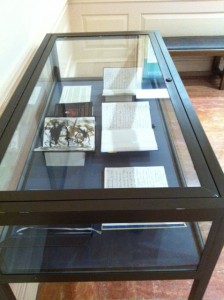

On display through February in Spencer Research Library’s lobby: five of the ten journals donated by the Burroughs estate.
In addition to the journals, the gift also includes typescripts and draft materials for the edition Grauerholz produced. Once cataloged, these “last words” of William S. Burroughs will be available for researchers and the public to consult at the Kenneth Spencer Research Library.
Elspeth Healey,
Special Collections Librarian
Tags: Allen Ginsberg, centenary, donation, Elspeth Healey, gifts, James Grauerholz, Kansas, KU Libraries, Last Words: The Final Journals of William S. Burroughs, Lawrence, twentieth century literature, University of Kansas, William S. Burroughs
Posted in Exhibitions, Special Collections |
No Comments Yet »
August 15th, 2013 Did you know that a windmill used to be the main landmark in Lawrence? The “Old Dutch Windmill,” as many called it, was located near the corner of what is now 9th Street and Emery Road. It was the first wind-driven mill in Kansas, and Lawrence was chosen as the location for the mill because there was a lot of grain farming in the area and the town was rapidly growing. The idea to erect the mill came from business partners John Wilder and Andrew Palmquist (whose name was later changed to Palm when he became a naturalized U.S. citizen). Palm returned to his native Sweden for several months to get help with the mill’s design. He brought back machinery as well as several millwrights—craftsmen who specialized in building windmills. Construction on the mill began in July of 1863. The mill sustained some minor damage during William Quantrill’s raid on Lawrence on August 21st of that same year. However, the damage was quickly repaired and the mill was completed in June of 1864.
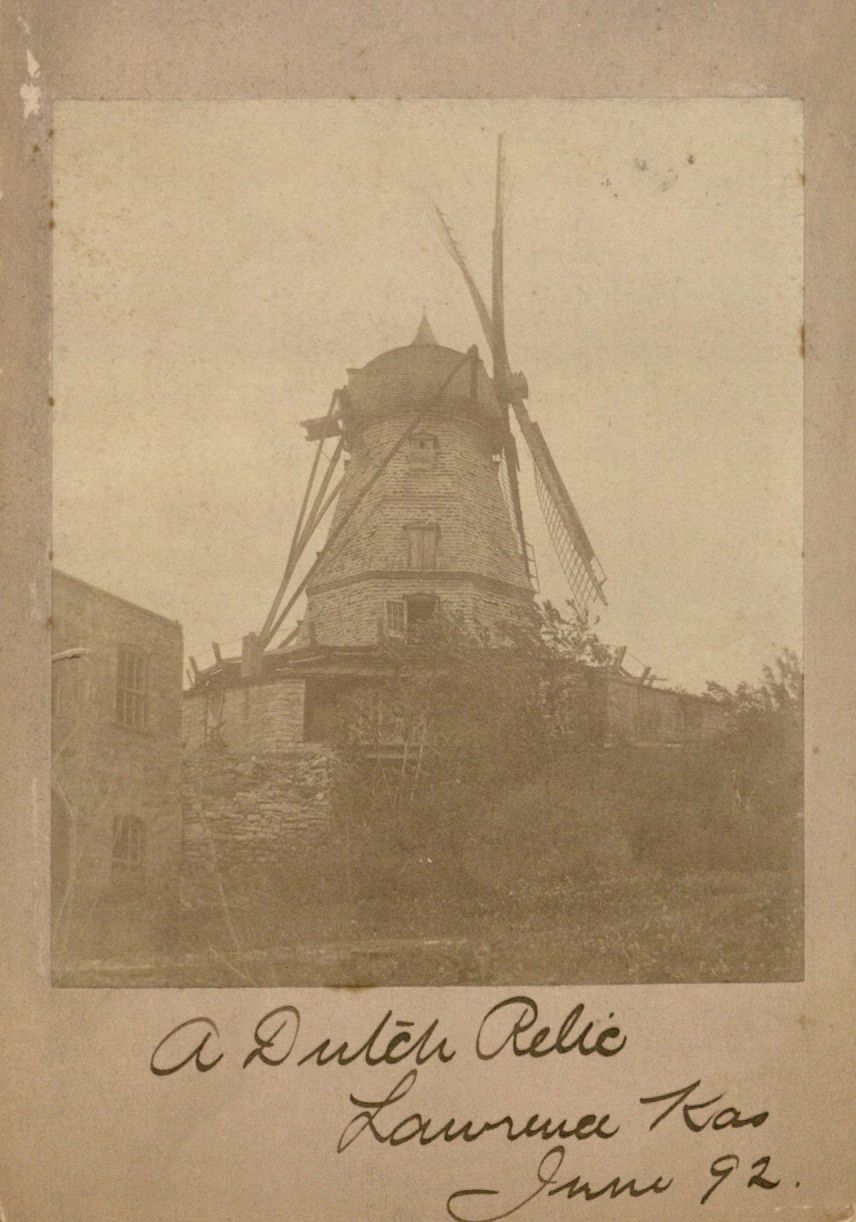

Left: “A Dutch Relic”: Lawrence Windmill, June 1892. Lawrence Photo Collection. Call Number: RH PH 18 E:5.
Right: Lawrence Windmill with man sitting where the windmill’s arms intersect, undated. Lawrence Photo Collection.
Call number RH PH 18 E:16(f). Click images to enlarge.
The Lawrence windmill had two sets of millstones—one to grind corn and the other to grind wheat—which were imported from France due to their high quality. The windmill measured 64 feet above ground level and each of the arms was 34 feet long. It had an octagonal shape, with shingles on the upper part of the windmill and a base made of stone. These features are considered typical of Dutch windmills. However, the Lawrence windmill had a unique feature with its onion-shaped dome, which can be seen on some Swedish churches.
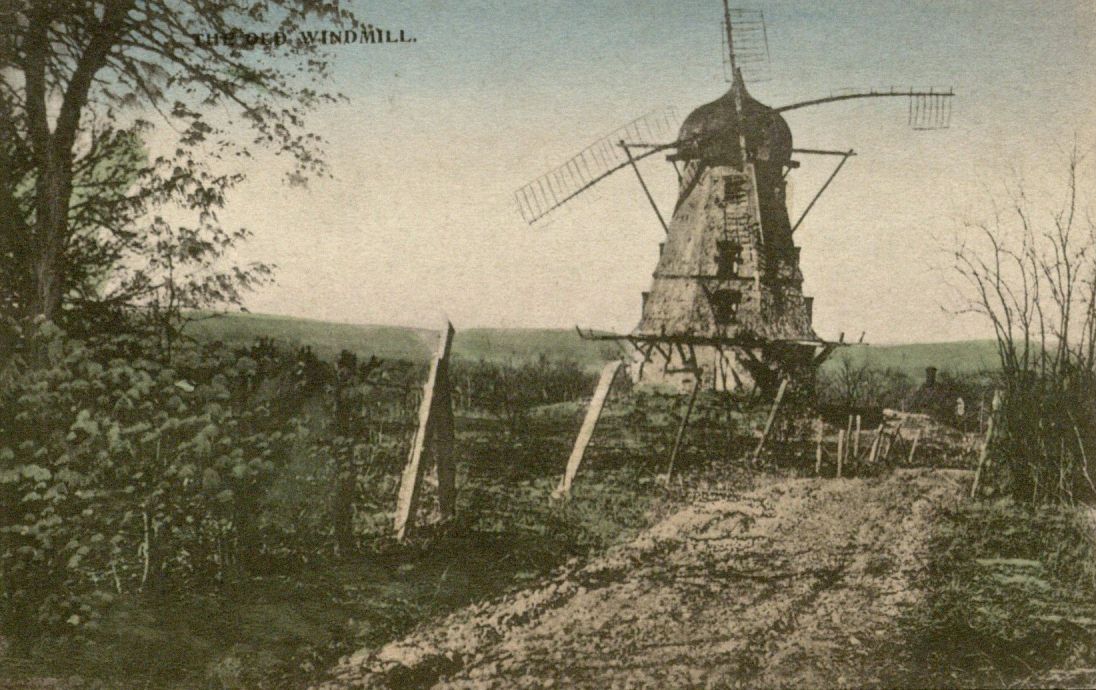
Color postcard of the Lawrence Windmill, undated. Lawrence Photo Collection. Call Number: RH PH 18 E:20.1.
Click image to enlarge.
Wilder and Palm used the windmill not only for grinding wheat and corn, but also to power their manufacturing business where they made carriages and plows. The business partners even produced their own brand of flour and were quite successful with their enterprises for several years. But by the 1880s there were larger mills in Douglas County that could grind more bushels of grain per day than the Lawrence windmill. Wilder and Palm had also acquired quite a bit of debt. In July of 1885, the company went into receivership—a type of corporate bankruptcy. Assets were liquidated over the next two years and the windmill stood unused until April 30, 1905 when it was destroyed by fire.
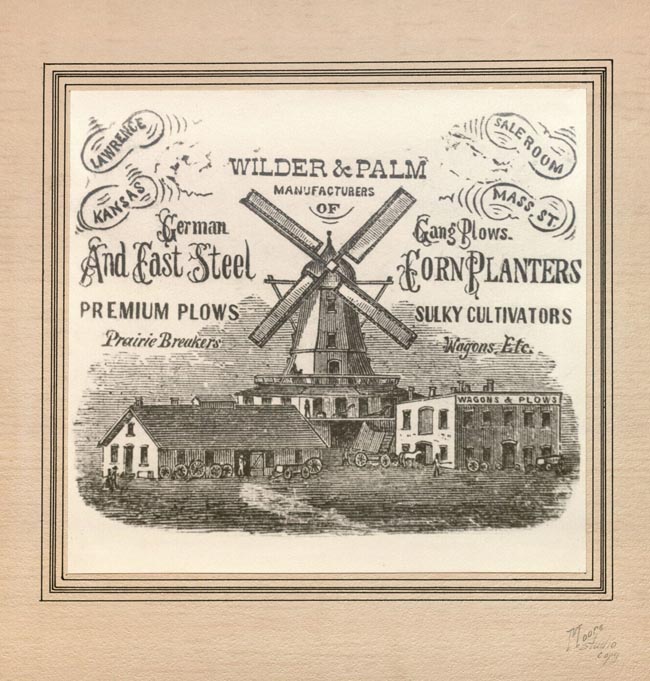
Advertisement for Wilder and Palm featuring the Lawrence Windmill, undated. Lawrence Photo Collection.
Call Number: RH PH 18 E:49(f). Click image to enlarge.
It was only after the mill stopped working that it became a symbol of the community. It was a popular picnic spot for KU students and was the subject of paintings, drawings, and photographs. More information about the “Old Dutch Windmill” can be found in John M. Peterson’s article “The Lawrence Windmill” in Kansas History: A Journal of the Central Plains, volume 3, issue 3, Autumn 1980, which is available in the Reading Room of the Kenneth Spencer Research Library (Call number F681 .K177 v.3:3). Additionally, in Spencer Library’s Kansas Collection, there is a paper entitled “Once Upon a Time: A Windmill in Lawrence” written by Jean Paul Pentecouteau in 1987 (Call number RH D6161). Pentecouteau was a student in KU’s School of Architecture and Urban Design.
Melissa Doebele
Public Services Student Assistant and 2013 Museum Studies Graduate
Tags: Andrew Palmquist, John Wilder, Lawrence, Melissa Doebele, Old Dutch Windmill, Quantrill's raid, Wilder and Palm, Windmills
Posted in Kansas Collection |
2 Comments »
















